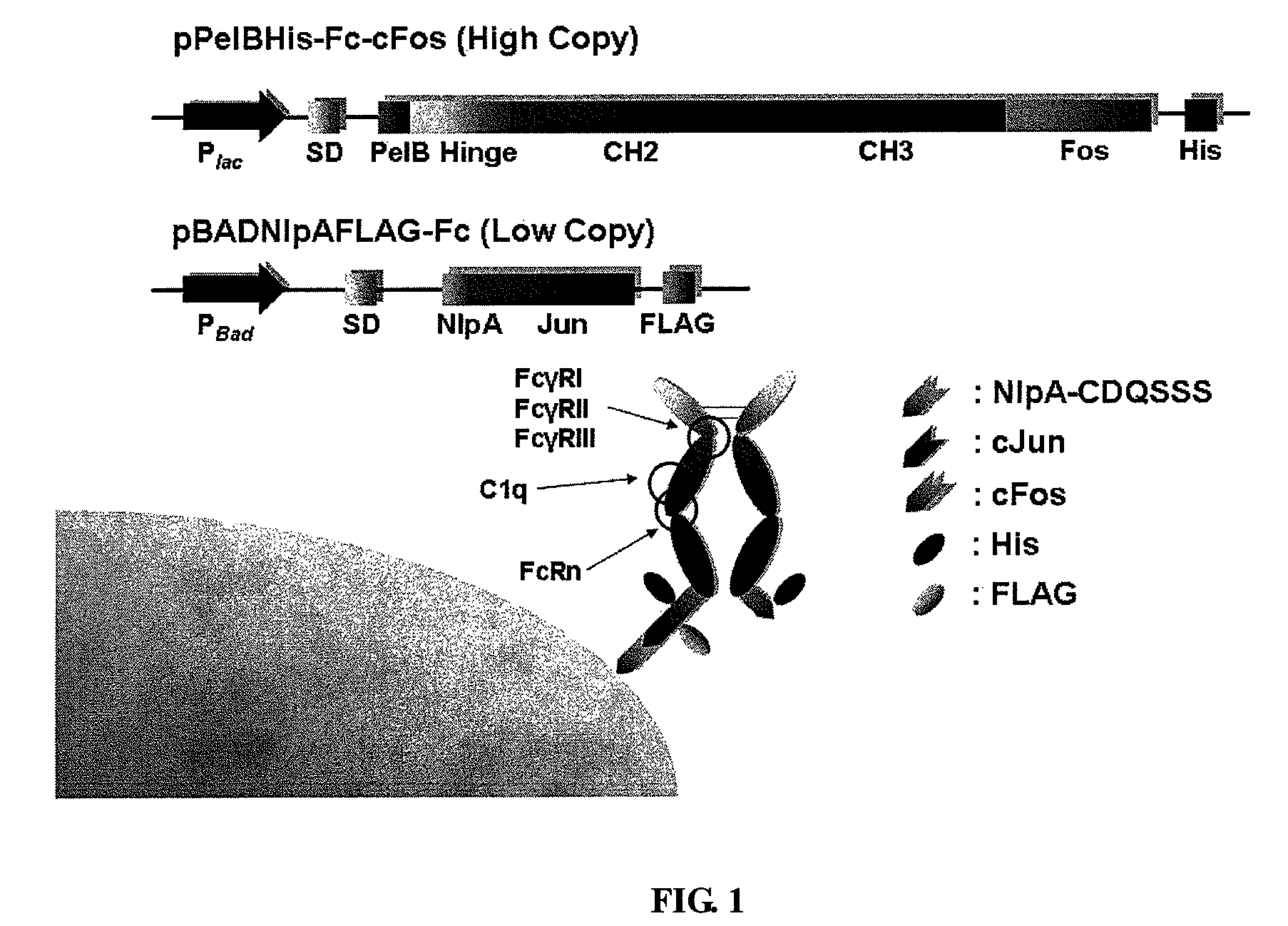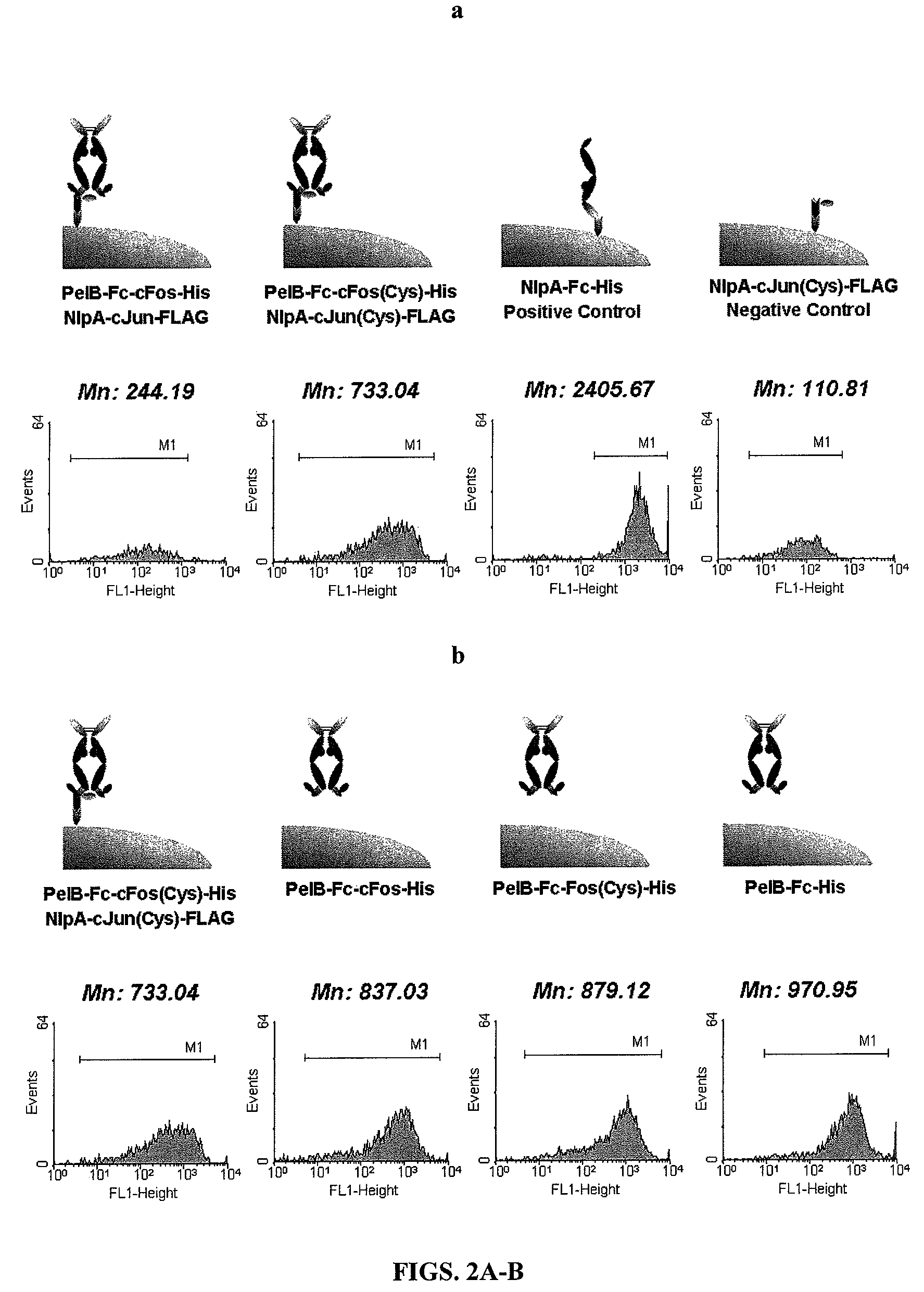Immunoglobulin Fc libraries
a technology of immunoglobulin and library, applied in the field of protein engineering, can solve problems such as disruption of the outer membrane, and achieve the effect of improving the binding capability of fcr
- Summary
- Abstract
- Description
- Claims
- Application Information
AI Technical Summary
Benefits of technology
Problems solved by technology
Method used
Image
Examples
example 1
Reagents for Studies
[0175]Oligonucleotides primers (Table 2) and restriction endonucleases used to construct plasmids to display homodimeric protein IgG-Fc were obtained from Integrated DNA Technologies (Coralville, Iowa) and New England Biolabs (Ipswich, Mass.), respectively. Taq Polymerase and FITC protein labeling kit were from Invitrogen (Carlsbad, Calif.). Recombinant human FcγRI / CD64 was purchased from R&D Systems (Minneapolis, Minn.). Trehalose was obtained from Fisher Scientific (Fair Lawn, N.J.). Human IgG-Fc and Rabbit anti-ECS antibody peroxidase conjugated were from Bethyl Laboratories (Montgometry, Tex.). Digoxigenin-BODIPY (Digoxigenin-4,4-difluoro-5,7-dimethyl-4-bora-3a,4a-diaza-s-indacene-3-propionyl ethylenediamine) was synthesized as described previously (Harvey et al., 2004). PA-FITC was obtained from List Biological Laboratories (Campbell, Calif.). Protein A-FITC and analytical grades of all other chemical reagents were purchased from Sigma-Aldrich (St. Louis, Mo...
example 2
Construction of Plasmids to Display Homodimeric Protein IgG-Fc
[0177]All plasmids and primers used in the present examples are described in Table 3 and Table 2. Plasmid pPelBHis was generated by ligating BamHI-HindIII digested skp gene from pMopac12 into pMopac1 digested with the same restriction endonucleases. pPelBFLAG was derived from pPelBHis in which polyhistidine tag and c-myc tag were replaced by FLAG tag (DYKDDDDK; SEQ ID NO:114). Subcloning of PCR amplified and SfiI digested Fc gene encoding human IgG1-Fc fragment, hinge, CH2 and CH3 region of human IgG1 heavy chain (GeneBank Accession No. AF237583; SEQ ID NO:83) into SfiI digested pPelBHis and pPelBFLAG generated pPelBHis-Fc and pPelBFLAG-Fc, respectively. pPelBHis-beta 2 microglobulin was constructed by subcloning soluble mature human beta 2 microglobulin gene synthesized from overlap PCR amplification using 10 primers including 2 external primers (STJ#78 and STJ#84; SEQ ID NOS:14 and 16) and 8 internal primers (STJ#86-93;...
example 3
Culture Conditions
Culture Conditions for Two Plasmids System
[0184]For the periplasmic display using leucine zippers, cJun-cFos, pPelBHis-Fc-cFos and pPelBHis-Fc-cFos(Cys) were co-transformed with pBADNlpAFLAG-cJun or pBADNlpAFLAG-cJun(Cys) into E. coli Jude-1. To display Fc using the interaction of ColE2-Im2, pPelBFLAG-Fc-Im2, pPelB-M18 scFv-Im2, and pPelBFLAG-2610 scFv-Im2 were co-transformed with pBADNlpAHis-ColE2(H574A), pBADNlpAHis-ColE2(H578A), or pBADNlpAHis-ColE2(H574 / 578) containing single or double mutations at C-terminal ColE2 DNase catalytic domain. The transformants harboring two plasmids were grown overnight at 37° C. with 250 rpm shaking in Terrific Broth (TB) (Becton Dickinson Diagnostic Systems DIFCO™, Sparks, Md.) supplemented with 2% (wt / vol) glucose, chloramphenicol (40 μg / ml) and ampicillin (50 μg / ml). After overnight culture, the cells were diluted 1:100 in fresh TB medium without glucose, incubated at 37° C. for 2 h and then cooled at 25° C. for 20 min. Firstly...
PUM
| Property | Measurement | Unit |
|---|---|---|
| equilibrium dissociation constant | aaaaa | aaaaa |
| sub-physiological temperature | aaaaa | aaaaa |
| volume | aaaaa | aaaaa |
Abstract
Description
Claims
Application Information
 Login to View More
Login to View More - R&D
- Intellectual Property
- Life Sciences
- Materials
- Tech Scout
- Unparalleled Data Quality
- Higher Quality Content
- 60% Fewer Hallucinations
Browse by: Latest US Patents, China's latest patents, Technical Efficacy Thesaurus, Application Domain, Technology Topic, Popular Technical Reports.
© 2025 PatSnap. All rights reserved.Legal|Privacy policy|Modern Slavery Act Transparency Statement|Sitemap|About US| Contact US: help@patsnap.com



